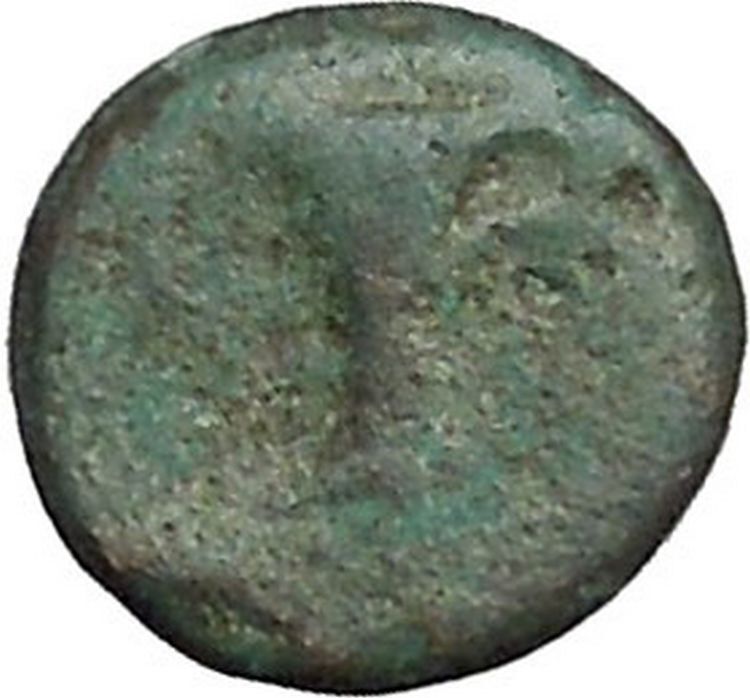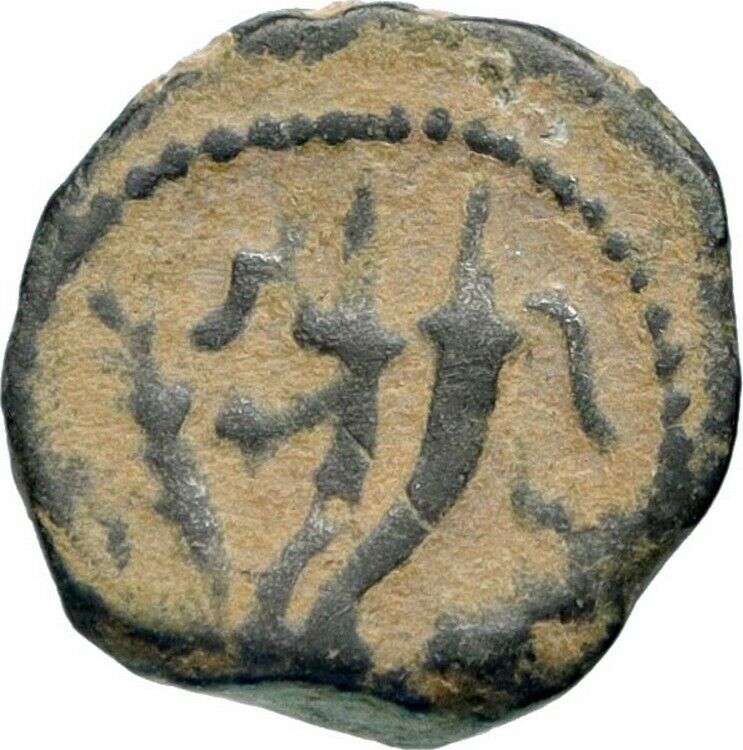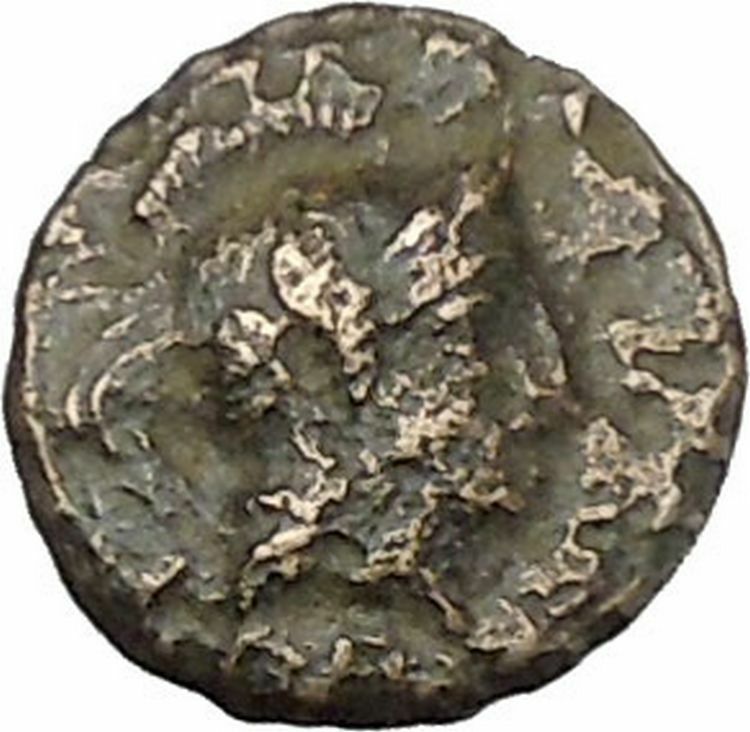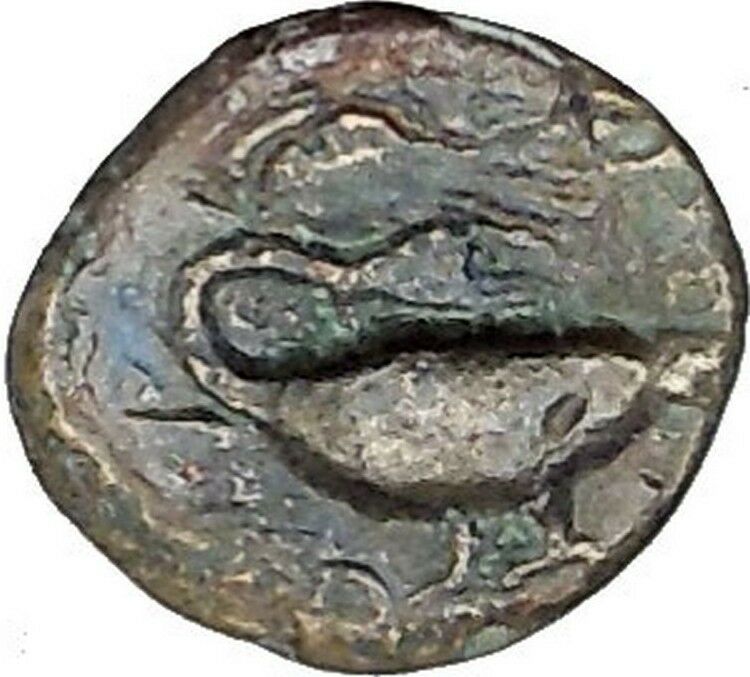|
Greek city of
Elaiussa Sebaste in
Pisidia
Bronze 17mm (3.74 grams) Struck 1st Century B.C.
Reference: SNG Levante 834; SNG France –
Turreted head of
Tyche right.
Hermes standing half-left, holding phiale and caduceus.
You are bidding on the exact item pictured,
provided with a Certificate of Authenticity and Lifetime Guarantee of
Authenticity.
Tyche (Greek for luck; the Roman equivalent was
Fortuna
) was the presiding
tutelary deity
that governed the fortune and
prosperity of a city, its destiny. Increasingly during the Hellenistic period,
cities had their own specific iconic version of Tyche, wearing a
mural crown
(a crown like the walls of the
city).

The
Greek historian Polybius
believed that when no cause can be
discovered to events such as floods, droughts, frosts or even in politics, then
the cause of these events may be fairly attributed to Tyche.
Stylianos Spyridakis concisely expressed Tyche’s appeal in a
Hellenistic world of arbitrary violence and unmeaning reverses: “In the
turbulent years of the
Epigoni of Alexander
, an awareness of the
instability of human affairs led people to believe that Tyche, the blind
mistress of Fortune, governed mankind with an inconstancy which explained the
vicissitudes of the time.”
In literature, she might be given various genealogies, as a daughter of
Hermes
and
Aphrodite
, or considered as one of the
Oceanids
, daughters of
Oceanus
and
Tethys
, or of
Zeus. She was connected with
Nemesis
and
Agathos Daimon
(“good spirit”).
She was uniquely venerated at
Itanos
in Crete, as Tyche Protogeneia,
linked with the Athenian
Protogeneia
(“firstborn”), daughter of
Erechtheus
, whose self-sacrifice saved the
city.
She had temples at
Caesarea Maritima
,
Antioch
,
Alexandria
and
Constantinople
. In
Alexandria
the Tychaeon, the temple of
Tyche, was described by
Libanius
as one of the most magnificent of the
entire Hellenistic world.
Tyche appears on many
coins
of the Hellenistic period in the three
centuries before the Christian era, especially from cities in the Aegean.
Unpredictable turns of fortune drive the complicated plotlines of
Hellenistic romances
, such as
Leucippe and Clitophon
or
Daphnis and Chloe
. She experienced a
resurgence in another era of uneasy change, the final days of publicly
sanctioned
Paganism
, between the late-fourth-century
emperors
Julian
and
Theodosius I
who definitively closed the
temples. The effectiveness of her capricious power even achieved respectability
in philosophical circles during that generation, though among poets it was a
commonplace to revile her for a fickle harlot.
In medieval art
, she was depicted as carrying a
cornucopia
, an
emblematic
ship’s rudder, and the
wheel of fortune
, or she may stand on the
wheel, presiding over the entire circle of fate.
The constellation of
Virgo
is sometimes identified as the heavenly
figure of Tyche, as well as other goddesses such as
Demeter
and
Astraea
.

Statue of Hermes wearing the
petasos
, a voyager’s cloak, the
caduceus and a purse. Roman copy after a Greek original (Vatican
Museums). |
Hermes is the great
messenger of the gods in
Greek mythology
and additionally as a
guide to the Underworld
. Hermes was born on
Mount Cyllene
in Arcadia. An
Olympian god
, he is also the patron of
boundaries and of the travelers who cross them, of
shepherds
and
cowherds
, of the cunning of thieves and liars,
of orators and wit, of literature and poets, of athletics and sports, of weights
and measures, of invention, and of commerce in general. His symbols include the
tortoise, the rooster, the winged sandals, the winged hat, and the
caduceus
(given to him by Apollo in exchange
for the lyre).
Symbols of Hermes were the palm tree, turtle, rooster, goat, the number four,
several kinds of fish, incense. Sacrifices involved honey, cakes, pigs, goats,
and lambs.
In the Roman adaptation of the Greek religion (see
interpretatio romana
), Hermes was
identified with the Roman god
Mercury
, who, though inherited from the
Etruscans
, developed many similar
characteristics, such as being the patron of commerce.
The
Homeric hymn
to Hermes invokes him as the one
“of many shifts (polytropos), blandly cunning, a robber, a cattle driver,
a bringer of dreams, a watcher by night, a thief at the gates, one who was soon
to show forth wonderful deeds among the deathless gods.”
He protects and takes care of all the travelers, miscreants, harlots, old
crones
and thieves that pray to him or cross
his path. He is athletic and is always looking out for runners, or any athletes
with injuries who need his help.
Hermes is a messenger from the gods to humans, sharing this role with
Iris
. An interpreter who bridges the boundaries
with strangers is a hermeneus. Hermes gives us our word “hermeneutics“,
the study and theory of interpretation. In Greek a lucky find was a hermaion.
Hermes delivered messages from Olympus to the mortal world. He wears shoes with
wings on them and uses them to fly freely between the mortal and immortal world.
Hermes was the second youngest of the
Olympian gods
, being born before
Dionysus
.
Hermes, as an inventor of fire, is a parallel of the
Titan
,
Prometheus
. In addition to the
lyre, Hermes was believed to have invented many types of racing and
the sports of wrestling and boxing, and therefore was a patron of athletes.
According to prominent
folklorist
Yeleazar Meletinsky
, Hermes is a deified
trickster
. Hermes also served as a
psychopomp
, or an escort for the dead to help
them find their way to the
afterlife
(the
Underworld
in the Greek myths). In many Greek
myths, Hermes was depicted as the only god besides
Hades
,
Persephone
,
Hecate
, and
Thanatos
who could enter and leave the
Underworld without hindrance.
Hermes often helped travelers have a safe and easy journey. Many Greeks would
sacrifice to Hermes before any trip.
In the fully-developed Olympian pantheon, Hermes was the son of
Zeus and the
Pleiade
Maia
, a daughter of the Titan
Atlas
. Hermes’ symbols were the
cock
and the
tortoise
, and he can be recognized by his purse
or pouch, winged sandals
,
winged cap
, and the herald’s staff, the
kerykeion
. The night he was born he slipped
away from Maia and stole his elder brother
Apollo

Elaiussa
Sebaste or Elaeousa Sebaste (Greek:
Ελαιούσα Σεβαστή) was an ancient
Roman
town located 55 km (34 mi) from
Mersin
in the direction of
Silifke
in
Cilicia
on the southern coast of
Anatolia
(in modern-day
Turkey
). Elaiussa, meaning
olive
, was founded in the 2nd century
B.C.
on a tiny island attached to the mainland
by a narrow isthmus in
Mediterranean Sea
.
Besides the cultivation of olives, the settlement here of the
Cappadocian
king
Archelaus
during the reign of the Roman Emperor
Augustus
played a role in the development of
the city. Founding a new city on the isthmus, Archelaus called it Sebaste, which
is the
Greek
equivalent word of the
Latin
“Augusta”. The city entered a golden age
when the Roman Emperor
Vespasian
purged
Cilicia
of pirates in 74
AD
. Towards the end of the 3rd century AD
however its importance began to wane, owing in large part to incursions by the
Sassanian
King
Shapur I
in 260 and later by the
Isaurians
. The ancient sources tell the history
of city’s existence and how the churches and basilicas survived into the late
Roman and early
Byzantine
periods. When its neighbor
Corycus
began to flourish in the 6th century
AD, Elaiussa Sebaste was slowly obliterated from the stage of history.
The island that was the site of the first settlement here, where excavations
have been underway since 1995 headed by
Italian
archeologist
Eugenia Equini Schneider, is
almost completely buried under sand. The original settlement, at a location that
provided security for the harbors on either side, is a peninsula today. The
ruins of a bath, a
cistern
, a defense wall and a breakwater can be
seen on the side overlooking the western bay of the peninsula. But the most
important remains unearthed in the city are a bath whose floor is paved with
mosaics and a small basilica on a circular base.
A building on the main street of city (east of the theater)
On the opposite side of the highway
D.400
that divides Elaiussa and Sebaste today
stands a theater dating to the 2nd century AD, an extremely small structure with
only 23 rows of seats, whose steps and decorations unfortunately succumbed to
centuries of plunder. Next to the theater is the
agora
, built in all great probability during
the imperial period. At the entrance of the agora, which is surrounded by a
semi-destroyed defense wall once rose two monumental fountains in the shape of
lions. Inside the agora stands a large church, its floor is covered by sand to
protect the mosaic pavement. Elaiussa’s only temple stands outside the city on a
hill overlooking the sea. Only two of the
Corinthian columns
of this temple, which had 12
on the long and 6 on the short side originally, are standing today. A large bath
complex among the lemon groves between the temple and the agora was built by a
technique characteristic of the ancient Roman period and little used in
Anatolia
.
Ruines and turkish village (1860)
The ruins of Elaiussa Sebaste also harbor the richest and most impressive
necropolis
among the cities of ancient Cilicia.
The “Avenue of Graves”, located on a hill to the north of the city, preserves
close to a hundred graves of various shapes and sizes scattered among the lemon
trees. The aesthetic forms of these monumental graves of Cilicia Tracheia are
remarkable.
The ancient aqueducts that carried water to the ruins from the Lamos
(“Lemon”) river also adorn the city’s two entrances. The aqueduct to the west of
the city in particular is in relatively good condition. Centuries ago these
aqueduct, as delicate as necklaces, actually formed a canal system that ran all
the way to Corycus.
A lidded
sarcophagus
lies on a small rise exactly
opposite the aqueduct. Known as “the Grave of the Princess”, this sarcophagus is
a prime example of the Anatolian tomb tradition.
|









_p275_-_VUE_DE_ELAEUSE_-_SEBASTE.jpg/330px-LANGLOIS(1861)_p275_-_VUE_DE_ELAEUSE_-_SEBASTE.jpg)
_p203_Tombeaux_antiques_a_Aiasch.jpg/330px-LANGLOIS(1861)_p203_Tombeaux_antiques_a_Aiasch.jpg)



